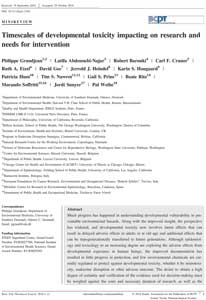 Budtz-Jørgensen, Esben and Philippe Grandjean. Application of benchmark analysis for mixed contaminant exposures: Mutual adjustment of perfluoroalkylate substances associated with immunotoxicity. PLoS One 13, 10 (2018): e0205388. doi: 10.1371/journal.pone.0205388. PMID: 30339706
Budtz-Jørgensen, Esben and Philippe Grandjean. Application of benchmark analysis for mixed contaminant exposures: Mutual adjustment of perfluoroalkylate substances associated with immunotoxicity. PLoS One 13, 10 (2018): e0205388. doi: 10.1371/journal.pone.0205388. PMID: 30339706
Developmental exposure to perfluorinated alkylate substances (PFAS) is associated with deficient IgG antibody responses to childhood vaccines. As this immunotoxicity outcome may represent a critical effect, calculation of benchmark dose (BMD) results would be useful for defining protective limits of exposure. However, exposures to the major PFAS that are associated with this adverse effect are interrelated, and mutually adjusted BMD results would be desirable. The BMDLs for the immunotoxicants were of similar magnitude before and after adjustment. As compared to linear dose-response models, the PFAS showed lower results for a piecewise linear model, which also provided a slightly better fit. Weaker associations with the antibody outcomes were observed after adjustments due to the correlation between the PFAS. However, while the adjustments resulted in elevated BMD results and p values, the BMDL values were not materially changed. Adjustment for co-exposure to a related immunotoxicant increased both the BMD values and their standard errors, though affected the BMDL values only to a negligible extent. Thus, when correlated toxicants appear to affect the same outcome and none of them is known a priori to be solely responsible, all exposures may be considered responsible in BMD calculations. Our BMDL results, both before and after adjustment are generally below current exposure levels and therefore suggest that all five perfluorinated substances should attract regulatory attention, at least until additional evidence shows otherwise.

